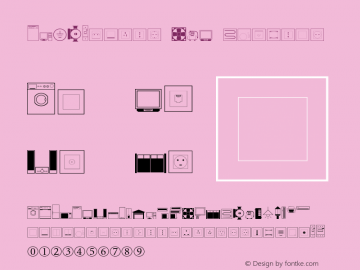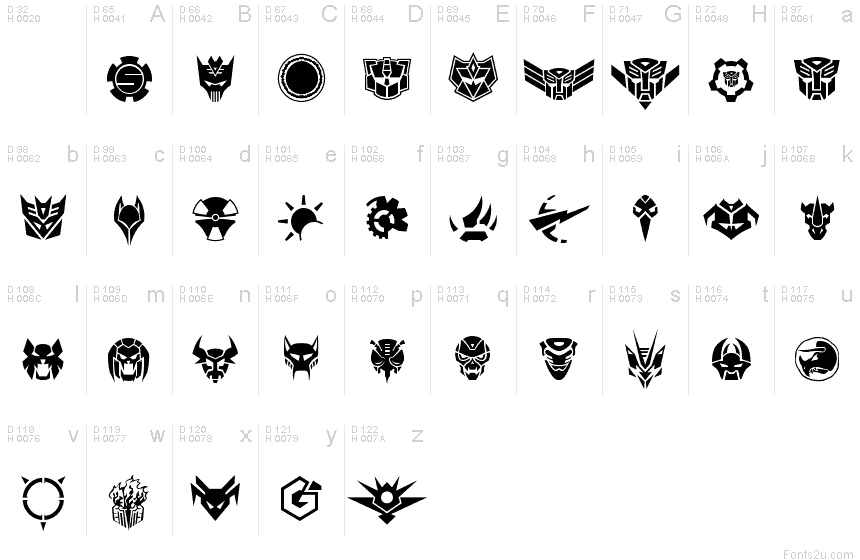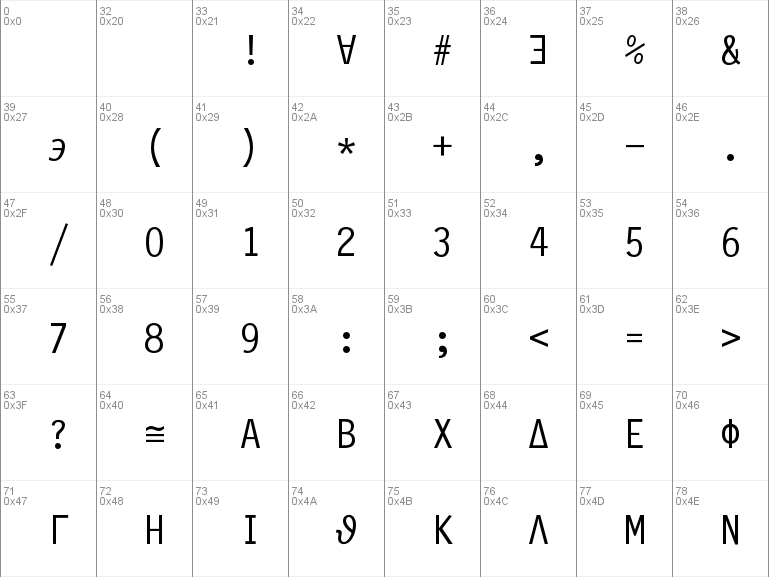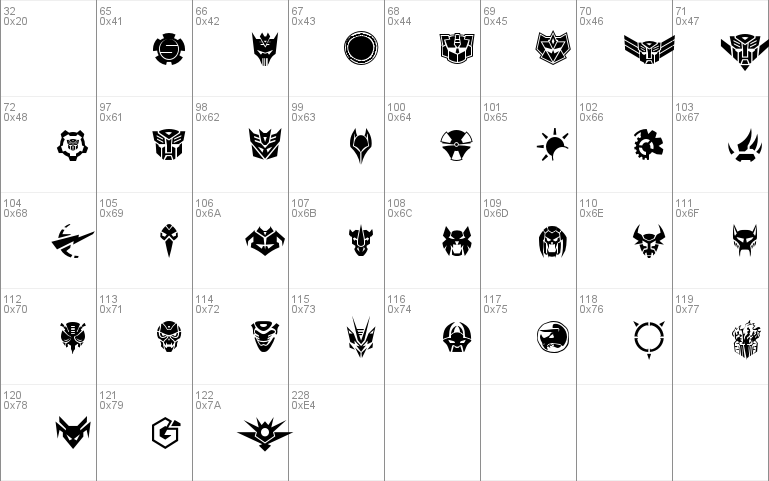Download @font-face. Web Symbols Regular is a font by Just Be Nice studio, designed by Igor Kiselev in 2011. WILD LOVE SYMBOLS (OTF, WOFF, 62 PNGS, VECTOR EPS) The symbols font includes 62 hand-drawn illustrations that can be used for all of your lovely creations. Once you install the symbols font, you can type out the letters a-z, A-Z, 1-10 or use the individual PNGs or vector eps file. PREMADE LOGOS (PSD, VECTOR EPS) 6 stunning premade logos for you.



- 2An Overview of STIX
Introduction
In this article we take a brief look at the STIX2 fonts, the latest set of high quality OpenType text and math fonts produced by the Scientific and Technical Information Exchange (STIX) font project. To assist with using and understanding the STIX2 fonts Overleaf is pleased to provide the following resources:
- an Overleaf template containing the STIX2 fonts loaded and configured ready for use;
- a short video showing the wealth of glyphs contained in the STIX2Math.otf math font;
- a detailed glyph chart for STIX2Math.otf produced with, and for use with, LuaTeX (LuaLaTeX).
An Overview of STIX
Development of the STIX fonts is funded and managed through STI Pub, a consortium of publishers of mathematical, scientific, and technical books and journals:
Version 1.0 of the STIX fonts were released on 24 May 2010 followed by additional interim releases—the latest version can be downloaded from the GitHub repository. The current version of the STIX fonts, version 2, were released on 1 December 2016, delivering the latest set of fonts to arise from a project that spans over 2 decades. Included in the version 2 release are 5 OpenType fonts:
- STIX2Math.otf
- STIX2Text-Bold.otf
- STIX2Text-BoldItalic.otf
- STIX2Text-Italic.otf
- STIX2Text-Regular.otf
The accompanying release notes observe:
“Version 2.0.0 of the STIX fonts, now known as 'STIX Two', is a thorough revision undertaken by the renowned type house Tiro Typeworks. The STIX Two fonts consist of four text fonts (Regular, Italic, Bold, and Bold Italic) and one Math font. Together, they provide a uniform set of fonts that can be used throughout the production process, whether that be a traditional print-only process, an entirely electronic one, or a combination of the two.”
Where can I get the STIX2 fonts?
The latest version of the STIX fonts can be downloaded from GitHub.
STIX2/OpenType: for use with XeTeX and LuaTeX only
The STIX2 fonts are designed for use with modern TeX engines— LuaTeX and XeTeX—because those engines are capable of using OpenType fonts and both support OpenType-based mathematical typesetting. You can use the STIX2 fonts with Plain TeX (using LuaTeX or XeTeX) but you’ll need to undertake a lot of configuration (setting math codes etc) to enable them with Plain TeX. This excellent example on tex.stackexchange shows the sort of configuration you’ll need to undertake—for thousands of characters. Fortunately for LaTeX users the unicode-math package has done all this hard work for you.
To have both your text and mathematics typeset with the STIX2 fonts you just need to use the fontspec package package (to configure the STIX2 text fonts) and the unicode-math package to configure and enable the STIX2 math font.
Laying the foundations: Unicode math encoding
A key prerequisite to production of the STIX fonts was creating a comprehensive/definitive list of the symbols in use by those needing to write and publish mathematics—which symbols (glyphs) should be contained in the font(s)? Through literature searches, liaison with publishers, consultations with authoring communities and examination of existing technical standards, such a list was constructed and applications were made to the Unicode Technical Committee to have that set of symbols formally approved for inclusion into the Unicode standard. For the purposes of Unicode, mathematics has specific challenges because of the subtleties presented by glyphs with slightly different visual appearances actually having quite different semantics, thus needing to be encoded separately.
Some interesting background on obtaining formal Unicode approval can be found in the paper Unicode and math, a combination whose time has come — Finally! written by Barbara Beeton (of the AMS) whose work has been instrumental in the success of the STIX project. Readers looking for further background information may also like to read the Unicode® Technical Report #25: UNICODE SUPPORT FOR MATHEMATICS.
Another milestone: OpenType-based math typesetting pioneered by Microsoft
Obtaining Unicode approval to encode a large number of mathematical characters (symbols) was a crucial first step in producing the STIX fonts. Another vital ingredient was an extension to the OpenType font specification which enabled OpenType fonts to contain additional data required by mathematical typesetting engines. This was pioneered by Microsoft through the specification of the MATH table in OpenType fonts and made its debut with Microsoft Word 2007 which contained a new and very powerful typesetting engine together with the first OpenType math font: Cambria Math. Additional background can be found in the article High-Quality Editing and Display of Mathematical Text in Office 2007 (by Professor Murray Sargent).
TeX-based mathematical typesetting involves a complex interplay between the algorithms built into TeX-based typesetting engines and the fonts used for math typesetting. Fonts designed for mathematics need to contain a number of parameters which are used in the sizing/positioning calculations deep inside TeX-based typesetting engines. The MATH table parameters defined by the OpenType specification are detailed here.

TeX engines follow suit
It was a natural progression for TeX engines to support OpenType math typesetting and, as noted in the presentation The state of OpenType math typesetting (by Ulrik Vieth, 2011) XeTeX introduced support for OpenType math in version 0.97 (2007) and LuaTeX added it in in version 0.4 (2009). The LuaTeX and XeTeX implementations usually produce compatible results but there is the possibility for some slight variation/differences in behaviour between the two engines.
Readers wishing to explore the parameters requited by legacy TeX fonts or the newer OpenType fonts can refer to an appendix contained in the unicode-math package documentation which lists all the legacy (traditional) TeX math font parameters together with the new (OpenType) parameters used by XeTeX. Chapter 6 of LuaTeX’s Reference Manual similarly lists the parameters used by LuaTeX’s math typesetting engine.
An Overleaf template with the STIX2 fonts
At the time of writing (2017) the STIX2 fonts were not included in the latest TeX Live distribution. To help you use the STIX2 fonts on Overleaf we have prepared a “getting started” template which contains the STIX2 fonts loaded and configured for use via fontspec and unicode-math. Of course, feel free to reconfigure the fontspec and unicode-math packages with options that better suit your particular requirements.

The template is available on the Overleaf gallery.
Browsing the STIX2 math font: A video and a glyph table
The STIX2 math font (STIX2Math.otf) contains a wealth of symbols—over 5,200 glyphs as you can see in this short video (no sound) which shows the font opened inside FontLab Studio:
If you are interested to further explore the STIX2 math font (STIX2Math.otf) we have used LuaTeX to prepare a detailed glyph chart (PDF ~560kb)—the tabulated data is designed for use with LuaTeX.
Further reading
Readers interested to learn more about TeX’s math typesetting may like to read some of these excellent papers and articles:
- Math typesetting in TeX: The good, the bad, the ugly (by Ulrik Vieth)
- Appendix G illuminated (by Bogusław Jackowski)
- OpenType Math Illuminated (by Ulrik Vieth)
- Understanding the æsthetics of math typesetting (by Ulrik Vieth)
- Math in LuaTEX 0.40 (by Taco Hoekwater)
Overleaf guides
LaTeX Basics
Mathematics
Figures and tables
References and Citations
Languages
Document structure
Formatting
Fonts
Presentations
Commands
Field specific
Class files
Symbol Otf Regular Cut
Advanced TeX/LaTeX
Disclaimer : 'Free Fonts Pro dot COM' is a large font archive offering 45,915 free ttf(otf) fonts for direct download, including all kinds of truetype/opentype font styles in 103 font categories. 'Successful design starts from choosing a right font!' The Font is playing a significant role in your graphic designs. You may for sure find a collection of your favorite fonts for your designs or ppt tutorials by using the search box on top of the site; and you can easily make your favorites list in the member's area. A font is usually a .ttf file(truetype, or opentype .otf), can be used both for Windows and Mac. You may also simply make your pc more customized or make your ppt presentations more impressive by changing the font face or text style. Any one can download the fonts listed here. You can download as many fonts as you like. All fonts are free for personal usage and some are free for commercial use. You must check the font license first before using a specific font for commercial purpose. Font license detail and the designer's contact info can be found onthe font's detail page. You can submit your own font(s) as well to share with ourvisitors if you are a font designer.
August 13, 2021 Live Statistics: 45,915 Total Fonts in Archive | 3,298,996,368 Total Downloads | 0 New Fonts in last 7 Days
how to install a font
1#, the font file you download here is usually in a '*.zip' format, simply extract it using a unzip tool, then you will get a '*.ttf/*.otf' font file
2#: windows 10/8/7/vista: right-click on the font file > 'install' | windows xp: put the font file into 'c:windowsfonts' folder | mac: double-click the font file > 'install font'